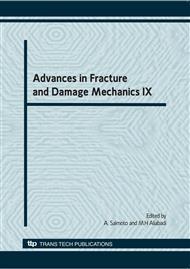p.537
p.541
p.545
p.549
p.553
p.557
p.561
p.565
p.569
Evaluating Damage of Concrete with Nonlinear Ultrasonic and Acoustic Emission Techniques
Abstract:
In this research, the non-linear ultrasonic and acoustic emission techniques were used to evaluating damages induced in concrete under compression loading. Cubic concrete specimens were produced with three different w/c. The nonlinear ultrasonic evaluation was based upon measuring the change in fundamental amplitude with increasing damage and output power level. In acoustic emission testing technique 4 sensors were used to record the AE events under various loading and unloading cycles. An increase in AE hits was observed with increasing damage. Since concrete contains microcracks even under initial loading stages, none of the test specimens exhibited clear signs of the occurrence of Kaiser Effect. Normalized values of Felicity Ratio were plotted and compared with the nonlinear ultrasonic test data. A correlation between acoustic emission and nonlinear ultrasonic techniques in assessing damage growth in concrete was investigated.
Info:
Periodical:
Pages:
553-556
Citation:
Online since:
November 2010
Authors:
Price:
Сopyright:
© 2011 Trans Tech Publications Ltd. All Rights Reserved
Share:
Citation:


